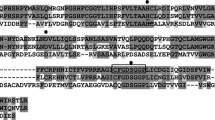Abstract
The effect of rat antimacrophage serum (rAMS) was tested on the influence of normal or thioglycollate-stimulated macrophage populations of the rat peritoneal cavity on the migration of polymorphonuclear neutrophils (PMN) induced by carrageenin, heterologous serum (rabbit) and sheep red blood cells. The rAMS used did not cross-react with PMN or lymphocytes nor did it affect circulating white cells, complement levels or lysed PMN present in the inflammatory exudate. It did, however, give a positive immunofluorescence reaction with resident and stimulated macrophages. The rAMS inhibited macrophage function as tested by sheep red blood cell phagocytosisin vivo and release of a PMN chemotactic factor(s)in vitro. Thioglycollate-stimuated peritoneal cavities showed an increased macrophage population and responded with increased PMN migration when challenged with heterologous serum or carrageenin, as compared with control rats. The presence of rat antimacrophage antibodies inhibited PMN migration induced by heterologous serum, sheep red blood cells and carrageenin. It is concluded that resident macrophages participate in the control of PMN migration to the site of an acute inflammation by acting as ‘alarm cells’ and triggering several defence mechanisms which ultimately protect the host from injurious stimuli.
Similar content being viewed by others
References
J.A. Kazmierowski, J.I. Gallin andH.Y. Reynolds,Mechanism for the inflammatory response in primate lungs. Demonstration and partial characterization of an alveolar macrophage-derived factor with preferential activity for polymorphonuclear leukocytes, J. clin. Invest.59, 273–281 (1977).
G.W. Hunninghake, J.I. Gallin andA.S. Fauci,Immunologic reactivity of the lung. The in vivo and in vitro cultured human alveolar macrophages, Clin. Res.alveolar macrophages, Am. Rev. resp. Dis.117, 15–23 (1978).
W. Merrill, G.P. Naegel, R.A. Matthay andH.Y. Reynolds,Production of chematactic factor(s) by in vitro cultured human alevolar macrophages, Clin. Res.26, 635a (1978).
K. McCarthy andP.M. Henson,Induction of lysosomal enzyme secretion by alveolar macrophages in response to the purified complement fragments C 5a and C 5a des-arg., J. Immun.123, 2511–2517 (1979).
W.W. Merrill, G.P. Naegel, R.A. Matthay andH.Y. Reynolds,Alveolar macrophage-derived chemotactic factor. Kinetics of in vitro production and partial characterization, J. clin. Invest.65, 268–276 (1980).
J.H. Dauber andR.P. Daniele,Secretion of chemotaxins by guinea-pig lung macrophages. I. The spectrum of inflammatory cell responses, Exp. Lung. Res.1, 23–32 (1980).
F.H. Valone, M. Franklin, F.F. Sun andE.J. Goetzl,Alveolar macrophage lipoxygenase products of arachidonic acid. Isolation and recognition as the predominant constituents of the neutrophil chemotactic activity elaborated by alveolar macrophages, Cell. Immunol.54, 390–401.
J.E. Gadek, G.W. Hunninghake, R.L. Zimmerman andR.G. Crystal,Regulation of the release of alveolar macrophage-derived neutrophil chemotactic factor, Am. Rev. resp. Dis.121, 723–33 (1980).
G.W. Hunninghake, J.E. Gadek andT.J. Lawley,Mechanisms of neutrophil accumulation in the lungs of patients with idiophathic pulmonary fibrosis, J. clin. Invest.68, 259–269 (1981).
C.I. Schoenberger, G.W. Hunninghake, O. Kawanami, V.J. Ferrans andR.G. Crystal,Role of alveolar macrophages in asbestosis: modulation of neutrophil migration to the lung after acute asbestos exposure, Thorax37, 803–809 (1982).
E.M. Lugano, J.H. Dauber andR.P. Daniele,Acute experimental silicosis — Lung morphology, histology and macrophage chemotaxin secretion, Am. J. Path.109, 27–36 (1982).
R.M. Kaelin, D.M. Center, J. Bernardo, M. Grant andG.L. Snider,The role of macrophage-derived chemoattractant activities in the early inflammatory events of bleomycin-induced pulmonary injury, Am Rev. resp. Dis.128, 132–137 (1983).
I.Y.R. Adamson andD.H. Bowden,Chemotactic ana mitogenic components of the alveolar macrophage response to particles and neutrophil chemoattractant Am. J. Path.109, 71–77 (1982).
T. Tono-Oka, M. Nakayama andS. Matsumoto Human monocyte-derived chemotactic factor for granulocytes, Immunol.39, 607–613 (1980).
M. Russo,The role of macrophages in the chemotactia response of polymorphonuclear leukocytes to bacteria lipopolysaccharides, Proc. Soc. exp. Biol. Med.134 326–330 (1980).
S.H. Ferreira, G.E.P. De Souza andR. Ribeiro dos Santos,In vivo inhibition of PMN migration by antimacrophage serum. In:Inflammation, Mechanisms and Treatment. Proceedings of the Fourth International Meeting on Future Trends in Inflammation, pp. 789–793, 1980.
L. Hudson andF.C. Hay,Practical Immunology, Blackwell Scientific Publications, Oxford London Edinburgh Melbourne 1976.
J.H. Hanks andJ.H. Wallace,Determination of cell viability, Proc. Soc. exp. Biol. Med.98, 188–192 (1985).
A.H. Coons andM.H. Kaplan,Localization of antigen in tissue cells. II. Improvements in a method for the detection of antigen by means of a fluorescent antibody, J. exp. Med.91, 1–13 (1950).
R. Ribeiro dos Santos andL. Hudson,Trypanosoma cruzi: Binding of parasite antigens to mammalian cell membranes. Parasite Immunol.2, 1–10 (1980).
D. English andB.R. Andersen,Single-step separation of red blood cells, granulocytes and mononuclear leukocytes on discontinuous density gradients of Ficoll-Hypaque, J. Immunol. Meth.5, 249–252 (1974).
A. Wadsworth, E. Maltaner andF. Maltaner,The quantitative determination of the fixation of complement by the immune serum and antigen, J. Immun.21, 313–340 (1931).
J.O. Almeida andE.H. Fife (eds),Métodos de fijación del complemento estandarizado cuantitativaments para la evaluacion crítica de antígenos preparados con Trypanosoma cruzi, Organizacion Panamericana de La Salud. Oficina Sanitaria Panamerican, Oficina regional de la Organizacion Mundial de la Salud. Washington, EUA 1976.
P.B. Medawar,Immunological tolerance, Nature189, 14–17 (1961).
O. Ouchterlony,Diffusion in gel methods for immunological analysis, Prog. Allergy2, 1–78 (1958).
R.D. Stevenson,Polymorph migration stimulator. A new factor produced by hydrocortisone-treated monocytes, Clin. exp. Immunol.17, 601–606 (1974).
P.A. Ward, E.R. Unanue, S.J. Goralnick andG.F. Schreiner,Chemotaxis of rat lymphocytes, J. Immun.119, 416–421 (1977).
G. Boltz-Nitulescu andO. Foster,Differences in the cytotoxic effect of rabbit anti-rat macrophage sera on rat alveolar and peritoneal macrophages, Immunobiol.156, 331–341 (1979).
K.J. Lavelle, B.D. Durland andM.N. Yum,The effect of antimacrophage antiserum on immune complex glomerulonephritis, J. Lab. clin. Med.98, 195–205 (1981).
H.Y. Reynolds, Lung inflammation: role of endogenous chematotactic factors in attracting polymorphonuclear granulocytes, Am. Rev. resp. Dis.127, S16-S25 (1983).
S.H. Ferreira,Are macrophages the body's alarm cells? Agents and Actions10, 229–230 (1980).
Author information
Authors and Affiliations
Rights and permissions
About this article
Cite this article
de Souza, G.E.P., Ferreira, S.H. Blockade by antimacrophage serum of the migration of PMN neutrophils into the inflamed peritoneal cavity. Agents and Actions 17, 97–103 (1985). https://doi.org/10.1007/BF01966691
Received:
Accepted:
Issue Date:
DOI: https://doi.org/10.1007/BF01966691



